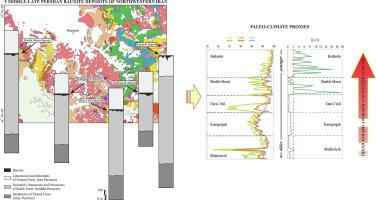当前位置:
X-MOL 学术
›
Ore Geol. Rev.
›
论文详情
Our official English website, www.x-mol.net, welcomes your
feedback! (Note: you will need to create a separate account there.)
Geochemistry and secular trends in the middle–late Permian karst bauxite deposits, northwestern Iran
Ore Geology Reviews ( IF 3.2 ) Pub Date : 2020-09-01 , DOI: 10.1016/j.oregeorev.2020.103660 Ali Abedini , Giovanni Mongelli , Maryam Khosravi , Rosa Sinisi
Ore Geology Reviews ( IF 3.2 ) Pub Date : 2020-09-01 , DOI: 10.1016/j.oregeorev.2020.103660 Ali Abedini , Giovanni Mongelli , Maryam Khosravi , Rosa Sinisi

|
Abstract This study focuses on the middle–late Permian bauxite deposits found within karstic depressions and sinkholes of carbonates of the Ruteh and Nessen Formations, northwestern Iran. Data concerning five karst bauxite deposits, each related to a different stratigraphic position within the bedrock, were selected to address the chemical distribution and inter-elemental relationships, especially for critical elements, factors that control bauxite formation, and the parental affinity. The analyzed samples, mainly clayey bauxite and bauxitic clay, are characterized by large compositional fluctuations involving both major and trace elements. The major element composition is dominated by SiO2, TiO2, Al2O3, and Fe2O3. Among the critical elements, compositional fluctuations induce the occurrence of outliers for Co, Nb, Ta, LREE, and HREE, similar to other trace elements, such as Ba, Sr, Cr, U, and Zr. Elemental mobility indicates that most of elements are generally depleted. Among the critical elements, Co is enriched only in several samples of the older deposits, and ΣREE are enriched in some samples of the younger deposits. Factor analysis suggests that, due to the observed Al–Ga covariance, fairly acidic conditions were never attained during bauxitization, and that detrital resistant minerals concentrated during a bauxitization stage, promoting Al–Ti accumulation. Furthermore, the U co-variance with low soluble elements (Nb, Ta, and Th) suggests that U was mostly conservative during the formation of deposits. Cobalt co-varies with Cr, and these elements accumulated during later bauxitization stages, when the massive leaching of silica occurred. The CIA, CIW, and PIA paleo-weathering proxies indicate an upward weathering increase, which suggests a trend toward more extreme weathering conditions in a wetter and warmer climate, according to the Permian global warming. This is consistent with an upward increasing Ba/Sr ratio and the inspection of the A–CN–K plot, where the younger deposits fall close to the A–K edge, involving a clayey precursor requires a rainfall increase. Interestingly, the upward trend toward a warmer and wetter climate was also coupled with paleo-redox conditions promoting cerium oxidation, as depicted by the Ce/Ce* values. Finally, the Eu anomaly and the Sm/Nd ratio indicate that the studied bauxite deposits were mainly derived from a mafic protolith that formed in the middle–late Permian, as a consequence of the volcanism that affected the entire Iranian platform. A cluster of karst bauxites, however, has Eu/Eu* values lower than the average-standard deviation range of the mafic rocks, suggesting a possible contribution of a more differentiated and less mafic protolith. Similarly, the U/Th ratio, at large, supports the hypothesis of a mafic protolith for the middle–late Permian bauxite deposits, although some samples show the U/Th values well above the average-standard deviation range of the mafic rocks, likely indicating that processes promoting the accumulation of resistant minerals with high U/Th ratios cannot be excluded. This means that, in this case, the U/Th ratio does not necessarily reflect the protolith of karst bauxites and that, more in general, this proxy needs to be carefully interpreted when used to assess the parental affinity of residual rocks.
中文翻译:

伊朗西北部中晚二叠世岩溶铝土矿床的地球化学和长期趋势
摘要 本研究的重点是在伊朗西北部 Ruteh 和 Nessen 组碳酸盐岩溶洼和落水洞中发现的中晚期二叠纪铝土矿矿床。选择了有关五个岩溶铝土矿矿床的数据,每个矿床都与基岩内的不同地层位置有关,以解决化学分布和元素间关系,尤其是关键元素、控制铝土矿形成的因素和亲本亲和力。分析的样品,主要是粘土质铝土矿和铝土质粘土,其特征在于涉及主要和微量元素的大成分波动。主要元素组成以SiO2、TiO2、Al2O3和Fe2O3为主。在关键元素中,成分波动导致 Co、Nb、Ta、LREE 和 HREE 异常值的出现,类似于其他微量元素,如 Ba、Sr、Cr、U 和 Zr。元素迁移率表明大多数元素通常是耗尽的。在关键元素中,Co仅在一些老矿床样品中富集,而ΣREE在一些新矿床样品中富集。因子分析表明,由于观察到的 Al-Ga 协方差,在铝土矿化过程中从未达到相当酸性的条件,并且在铝土矿化阶段,耐碎屑矿物集中,促进了 Al-Ti 的积累。此外,U 与低可溶性元素(Nb、Ta 和 Th)的协方差表明 U 在沉积物形成过程中主要是保守的。钴与 Cr 共变,这些元素在后期铝土化阶段积累,当二氧化硅大量浸出时。中央情报局、CIW、根据二叠纪全球变暖,PIA 古风化指标表明风化作用呈上升趋势,这表明在更潮湿和更温暖的气候中,风化条件趋向于更加极端的气候条件。这与向上增加的 Ba/Sr 比率和 A-CN-K 图的检查一致,其中较年轻的沉积物靠近 A-K 边缘,涉及粘土前体需要增加降雨量。有趣的是,气候变暖和潮湿的上升趋势还与促进铈氧化的古氧化还原条件相结合,如 Ce/Ce* 值所示。最后,Eu 异常和 Sm/Nd 比率表明所研究的铝土矿矿床主要来源于形成于二叠纪中晚期的镁铁质原岩,这是影响整个伊朗地台的火山作用的结果。然而,一组喀斯特铝土矿的 Eu/Eu* 值低于镁铁质岩石的平均标准偏差范围,这表明可能是分化程度更高、镁铁质含量更低的原岩的贡献。同样,U/Th 比值总体上支持中晚二叠世铝土矿床的基性原岩假设,尽管一些样品显示 U/Th 值远高于基性岩的平均标准偏差范围,可能表明不能排除促进具有高 U/Th 比率的抗性矿物积累的过程。这意味着,在这种情况下,U/Th 比率并不一定反映岩溶铝土矿的原岩,更一般地说,当用于评估残余岩石的亲缘关系时,需要仔细解释该代理。Eu/Eu* 值低于镁铁质岩石的平均标准偏差范围,这表明可能是分化程度更高且镁铁质含量较低的原岩的贡献。同样,U/Th 比值总体上支持中晚二叠世铝土矿床的基性原岩假设,尽管一些样品显示 U/Th 值远高于基性岩的平均标准偏差范围,可能表明不能排除促进具有高 U/Th 比率的抗性矿物积累的过程。这意味着,在这种情况下,U/Th 比率并不一定反映岩溶铝土矿的原岩,更一般地说,当用于评估残余岩石的亲缘关系时,需要仔细解释该代理。Eu/Eu* 值低于镁铁质岩石的平均标准偏差范围,这表明可能是分化程度更高且镁铁质含量较低的原岩的贡献。同样,U/Th 比值总体上支持中晚二叠世铝土矿床的基性原岩假设,尽管一些样品显示 U/Th 值远高于基性岩的平均标准偏差范围,可能表明不能排除促进具有高 U/Th 比率的抗性矿物积累的过程。这意味着,在这种情况下,U/Th 比率并不一定反映岩溶铝土矿的原岩,更一般地说,当用于评估残余岩石的亲缘关系时,需要仔细解释该代理。表明更分化和更少镁铁质的原岩的可能贡献。同样,U/Th 比值总体上支持中晚二叠世铝土矿床的基性原岩假设,尽管一些样品显示 U/Th 值远高于基性岩的平均标准偏差范围,可能表明不能排除促进具有高 U/Th 比率的抗性矿物积累的过程。这意味着,在这种情况下,U/Th 比率不一定反映岩溶铝土矿的原岩,而且更一般地说,当用于评估残余岩石的亲缘关系时,需要仔细解释该代理。表明更分化和更少镁铁质的原岩的可能贡献。同样,U/Th 比值总体上支持中晚二叠世铝土矿床的基性原岩假设,尽管一些样品显示 U/Th 值远高于基性岩的平均标准偏差范围,可能表明不能排除促进具有高 U/Th 比率的抗性矿物积累的过程。这意味着,在这种情况下,U/Th 比率并不一定反映岩溶铝土矿的原岩,更一般地说,当用于评估残余岩石的亲缘关系时,需要仔细解释该代理。支持中晚二叠世铝土矿床的基性原岩假设,尽管一些样品显示 U/Th 值远高于基性岩的平均标准偏差范围,这可能表明该过程促进了高抗性矿物的积累不能排除 U/Th 比率。这意味着,在这种情况下,U/Th 比率并不一定反映岩溶铝土矿的原岩,更一般地说,当用于评估残余岩石的亲缘关系时,需要仔细解释该代理。支持中晚二叠世铝土矿床的基性原岩假设,尽管一些样品显示 U/Th 值远高于基性岩的平均标准偏差范围,这可能表明该过程促进了高抗性矿物的积累不能排除 U/Th 比率。这意味着,在这种情况下,U/Th 比率并不一定反映岩溶铝土矿的原岩,更一般地说,当用于评估残余岩石的亲缘关系时,需要仔细解释该代理。
更新日期:2020-09-01
中文翻译:

伊朗西北部中晚二叠世岩溶铝土矿床的地球化学和长期趋势
摘要 本研究的重点是在伊朗西北部 Ruteh 和 Nessen 组碳酸盐岩溶洼和落水洞中发现的中晚期二叠纪铝土矿矿床。选择了有关五个岩溶铝土矿矿床的数据,每个矿床都与基岩内的不同地层位置有关,以解决化学分布和元素间关系,尤其是关键元素、控制铝土矿形成的因素和亲本亲和力。分析的样品,主要是粘土质铝土矿和铝土质粘土,其特征在于涉及主要和微量元素的大成分波动。主要元素组成以SiO2、TiO2、Al2O3和Fe2O3为主。在关键元素中,成分波动导致 Co、Nb、Ta、LREE 和 HREE 异常值的出现,类似于其他微量元素,如 Ba、Sr、Cr、U 和 Zr。元素迁移率表明大多数元素通常是耗尽的。在关键元素中,Co仅在一些老矿床样品中富集,而ΣREE在一些新矿床样品中富集。因子分析表明,由于观察到的 Al-Ga 协方差,在铝土矿化过程中从未达到相当酸性的条件,并且在铝土矿化阶段,耐碎屑矿物集中,促进了 Al-Ti 的积累。此外,U 与低可溶性元素(Nb、Ta 和 Th)的协方差表明 U 在沉积物形成过程中主要是保守的。钴与 Cr 共变,这些元素在后期铝土化阶段积累,当二氧化硅大量浸出时。中央情报局、CIW、根据二叠纪全球变暖,PIA 古风化指标表明风化作用呈上升趋势,这表明在更潮湿和更温暖的气候中,风化条件趋向于更加极端的气候条件。这与向上增加的 Ba/Sr 比率和 A-CN-K 图的检查一致,其中较年轻的沉积物靠近 A-K 边缘,涉及粘土前体需要增加降雨量。有趣的是,气候变暖和潮湿的上升趋势还与促进铈氧化的古氧化还原条件相结合,如 Ce/Ce* 值所示。最后,Eu 异常和 Sm/Nd 比率表明所研究的铝土矿矿床主要来源于形成于二叠纪中晚期的镁铁质原岩,这是影响整个伊朗地台的火山作用的结果。然而,一组喀斯特铝土矿的 Eu/Eu* 值低于镁铁质岩石的平均标准偏差范围,这表明可能是分化程度更高、镁铁质含量更低的原岩的贡献。同样,U/Th 比值总体上支持中晚二叠世铝土矿床的基性原岩假设,尽管一些样品显示 U/Th 值远高于基性岩的平均标准偏差范围,可能表明不能排除促进具有高 U/Th 比率的抗性矿物积累的过程。这意味着,在这种情况下,U/Th 比率并不一定反映岩溶铝土矿的原岩,更一般地说,当用于评估残余岩石的亲缘关系时,需要仔细解释该代理。Eu/Eu* 值低于镁铁质岩石的平均标准偏差范围,这表明可能是分化程度更高且镁铁质含量较低的原岩的贡献。同样,U/Th 比值总体上支持中晚二叠世铝土矿床的基性原岩假设,尽管一些样品显示 U/Th 值远高于基性岩的平均标准偏差范围,可能表明不能排除促进具有高 U/Th 比率的抗性矿物积累的过程。这意味着,在这种情况下,U/Th 比率并不一定反映岩溶铝土矿的原岩,更一般地说,当用于评估残余岩石的亲缘关系时,需要仔细解释该代理。Eu/Eu* 值低于镁铁质岩石的平均标准偏差范围,这表明可能是分化程度更高且镁铁质含量较低的原岩的贡献。同样,U/Th 比值总体上支持中晚二叠世铝土矿床的基性原岩假设,尽管一些样品显示 U/Th 值远高于基性岩的平均标准偏差范围,可能表明不能排除促进具有高 U/Th 比率的抗性矿物积累的过程。这意味着,在这种情况下,U/Th 比率并不一定反映岩溶铝土矿的原岩,更一般地说,当用于评估残余岩石的亲缘关系时,需要仔细解释该代理。表明更分化和更少镁铁质的原岩的可能贡献。同样,U/Th 比值总体上支持中晚二叠世铝土矿床的基性原岩假设,尽管一些样品显示 U/Th 值远高于基性岩的平均标准偏差范围,可能表明不能排除促进具有高 U/Th 比率的抗性矿物积累的过程。这意味着,在这种情况下,U/Th 比率不一定反映岩溶铝土矿的原岩,而且更一般地说,当用于评估残余岩石的亲缘关系时,需要仔细解释该代理。表明更分化和更少镁铁质的原岩的可能贡献。同样,U/Th 比值总体上支持中晚二叠世铝土矿床的基性原岩假设,尽管一些样品显示 U/Th 值远高于基性岩的平均标准偏差范围,可能表明不能排除促进具有高 U/Th 比率的抗性矿物积累的过程。这意味着,在这种情况下,U/Th 比率并不一定反映岩溶铝土矿的原岩,更一般地说,当用于评估残余岩石的亲缘关系时,需要仔细解释该代理。支持中晚二叠世铝土矿床的基性原岩假设,尽管一些样品显示 U/Th 值远高于基性岩的平均标准偏差范围,这可能表明该过程促进了高抗性矿物的积累不能排除 U/Th 比率。这意味着,在这种情况下,U/Th 比率并不一定反映岩溶铝土矿的原岩,更一般地说,当用于评估残余岩石的亲缘关系时,需要仔细解释该代理。支持中晚二叠世铝土矿床的基性原岩假设,尽管一些样品显示 U/Th 值远高于基性岩的平均标准偏差范围,这可能表明该过程促进了高抗性矿物的积累不能排除 U/Th 比率。这意味着,在这种情况下,U/Th 比率并不一定反映岩溶铝土矿的原岩,更一般地说,当用于评估残余岩石的亲缘关系时,需要仔细解释该代理。









































 京公网安备 11010802027423号
京公网安备 11010802027423号